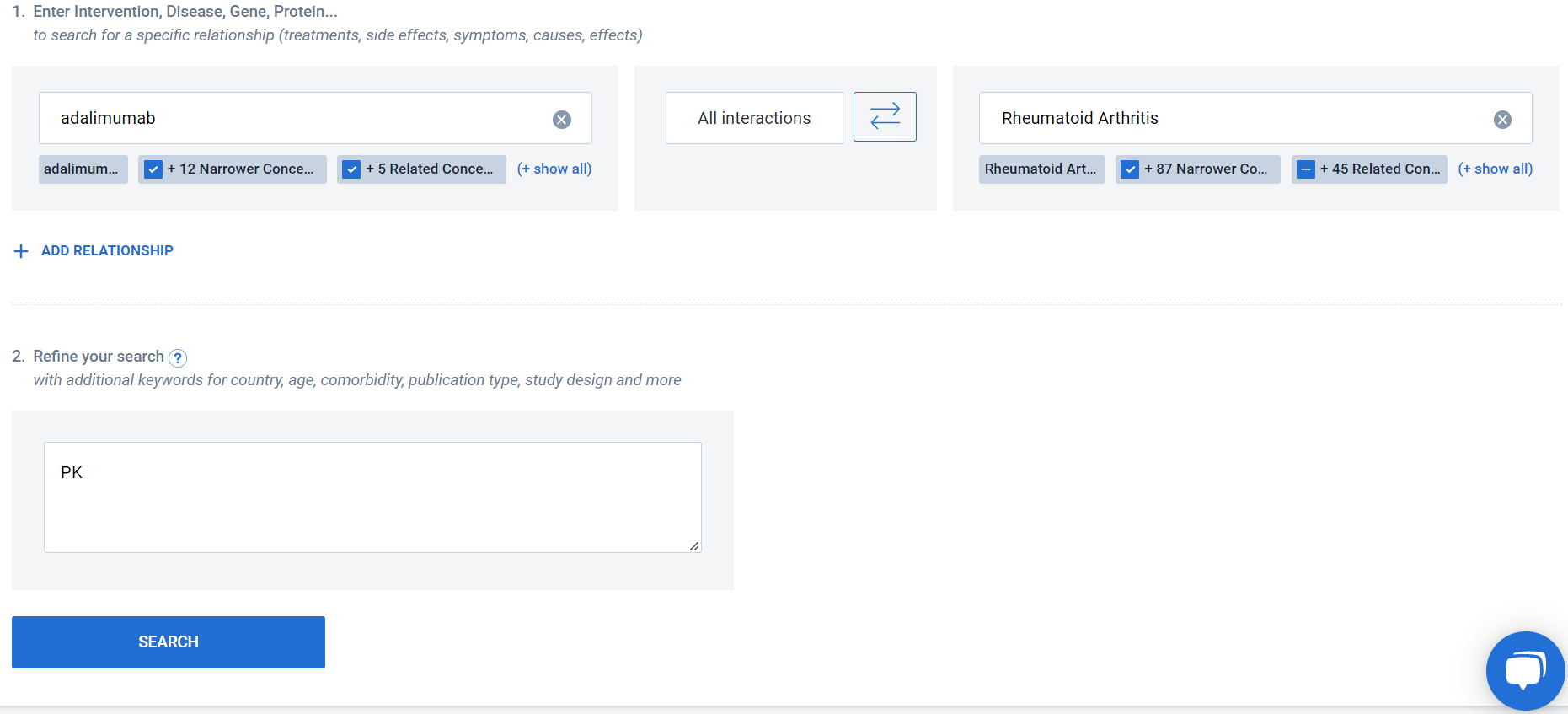In the Advanced Search you can look for causes or effects of a specific concept (similar to the Intelligent search module), but you can also:
A. Refine your results by using the keyword search
B. Search for direct relationships between 2 concepts
C. Add multiple concepts as comparators and create a delta analysis
Search strategy A: Refine your results by using the keyword search
Step 1: Search for causes or effects by filling the appropriate concept field
Fill the right side to find causes (e.g. treatments, biomarkers, risk factors) or the left side to find effects (e.g. side effects, associated diseases, symptoms)
TIP!
-
Searching for causes of a concept: fill only the right concept field. The left concept field is empty since we search for all incoming relationships (causes).

- Searching for effects of a concept: fill only the left concept field.
The right concept field is empty since we search for all outgoing relationships (effects).

You can refine your search by selecting the most relevant narrower and related concepts. By default, the system includes the most relevant concepts in your query. Click on the (+show all) button to review the concepts included.
 Depending on your question, you can refine your search by using the All interactions button and select specific arrows. For example, if you are looking for treatments of a disease select the DOWNREGULATE arrow to find causes that “decrease” the disease.
Depending on your question, you can refine your search by using the All interactions button and select specific arrows. For example, if you are looking for treatments of a disease select the DOWNREGULATE arrow to find causes that “decrease” the disease.

Step 2: Input keywords in the free text field to further refine the article corpus that you are interested in
If keyword search is used, the system will first surface all the articles that meet the keyword search criteria and then will find relevant relationships within these articles. For more details, please visit the keyword search section.
▶️Example question: Treatment landscape of COVID-19 in COPD patients (search link).

In this case the system surfaces all articles that refer to COPD patients and from within these articles it extracts all the relationships referring to the causes of COVID-19.
Step 3: Click on SEARCH
To further refine your results based on your question you can filter using UMLS categories (e.g. Pharmacologic Substances, Disorders, Biomarkers). For example, if you are searching for treatments of a disease select the UMLS category Pharmacologic substance under Chemicals & Drugs.

TIP! You can also look for treatments of COVID-19 in COPD patients, in the Intelligent Search module. Causaly will automatically perform the search for you by using the relevant keywords and filters by default (link).
Example questions for search strategy A
1. Use of adalimumab only in humans (search link)
2. Treatments for rheumatoid arthritis in patients that have osteoporosis (search link)
3. Treatments targeting BRCA1/BRCA2 breast cancer (search link)
4. Treatments for pediatric psoriasis (search link)
5. Immunohistochemistry data for BCL-2 expression (search link)
Search strategy B: Searching for a direct relationship between two concepts.
Step 1: Fill both concept fields with the appropriate concepts relevant to your question and find all articles associating these concepts by clicking SEARCH
▶️Example question: The relationship between adalimumab and rheumatoid arthritis (search link).

When searching for a specific relationship, the system displays by default the results in the ARTICLES view. The results are sorted by relevance and include:
-
Articles that mention the relationship in the same sentence (prioritized)
-
Articles that contain indirect relationships
-
Other relevant articles based on term co-occurrence to maximize search sensitivity
In the RELATIONSHIPS view the system displays only the direct relationships between the two concepts.
TIP!
You can further refine the results based on specific criteria by using the keyword search field as in Search Strategy A - Step 2
▶️Example question: The relationship between adalimumab and rheumatoid arthritis coming from pharmacokinetic studies (search link).

The system surfaces all articles that report pharmacokinetics and then looks for the effects of adalimumab in rheumatoid arthritis inside these articles.
TIP! Similar to keyword search (Search Strategy A), searching for an association between two concepts of interest can automatically be performed in Intelligent Search.
Example questions for search strategy B:
1. Relationship between PD-L1 and breast cancer (search link)
2. Drug-drug interaction between cimetidine and warfarin (search link)
3. The relationship between smoking and lung cancer(search link)
Search strategy C: Add multiple concepts and perform a comparative analysis.
Step 1: Search for causes or effects by filling the appropriate concept field as in Search strategy A - Step 1.
Step 2: Click the Add Relationship button to include additional comparators.
Step 3: When satisfied with the number of comparators, click on SEARCH.
TIP! Searching by multiple rows is equivalent to searching for relationships for concept A, concept B, etc separately, meaning that the results might not be related to all concepts but only to one of them.
▶️Example question: Comparative analysis on the effects of adalimumab, etanercept and rituximab (search link).
Step 4: In the results section, select the delta analysis view to explore common and unique relationships of the selected concepts

Example questions for search strategy C
1. Common and unique biomarkers for rheumatoid arthritis, psoriasis and lupus erythematosus (search link).
2. Comparative analysis on the effects of erlotinib and gefitinib (search link).
3. Neoplastic processes associated with AKT1, CD274 and PTEN genes (search link).
TIP!
You can further refine the results based on specific criteria by using publication-related filters available in the Causaly cloud, such as the publication type, article section, data source etc. For more information on how to use the filters, please click here.